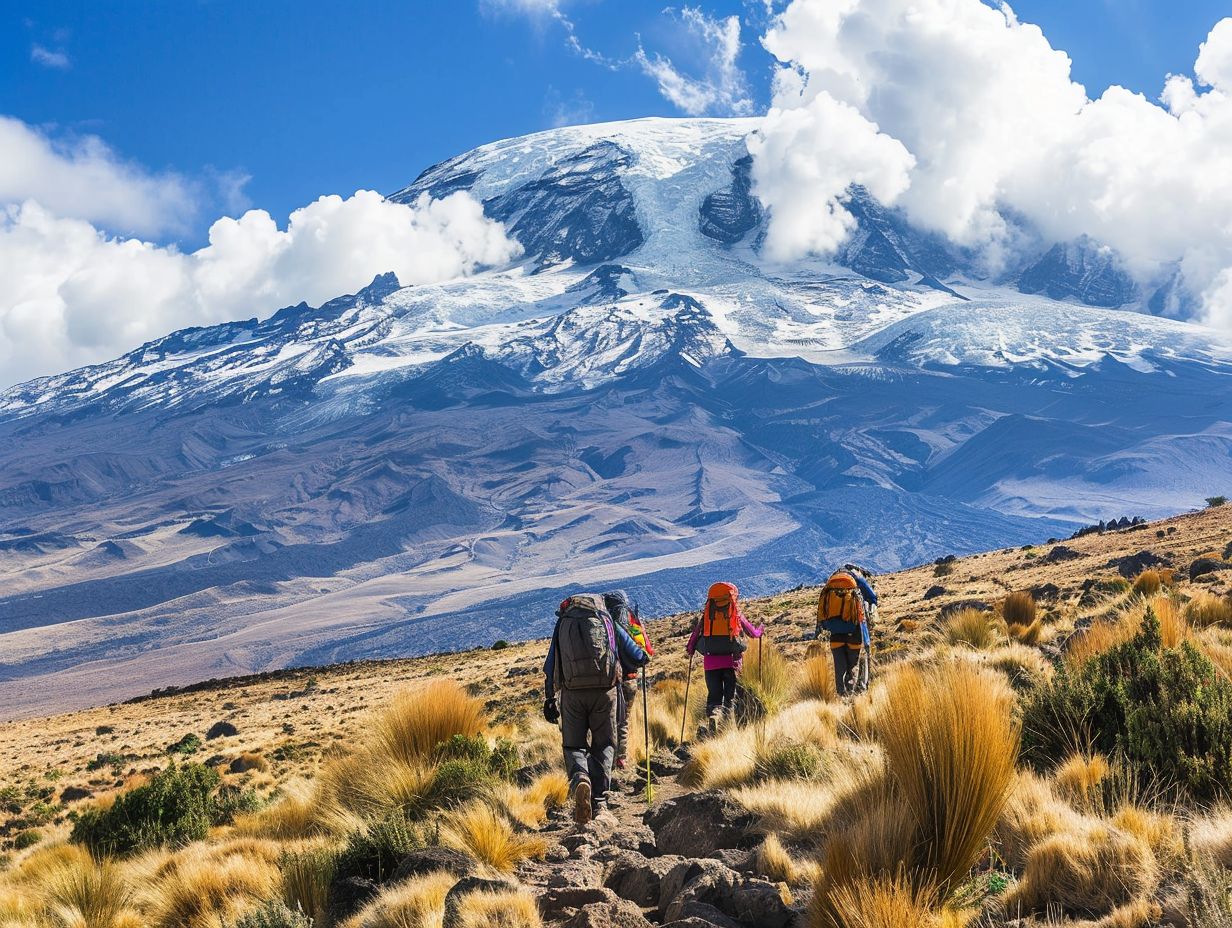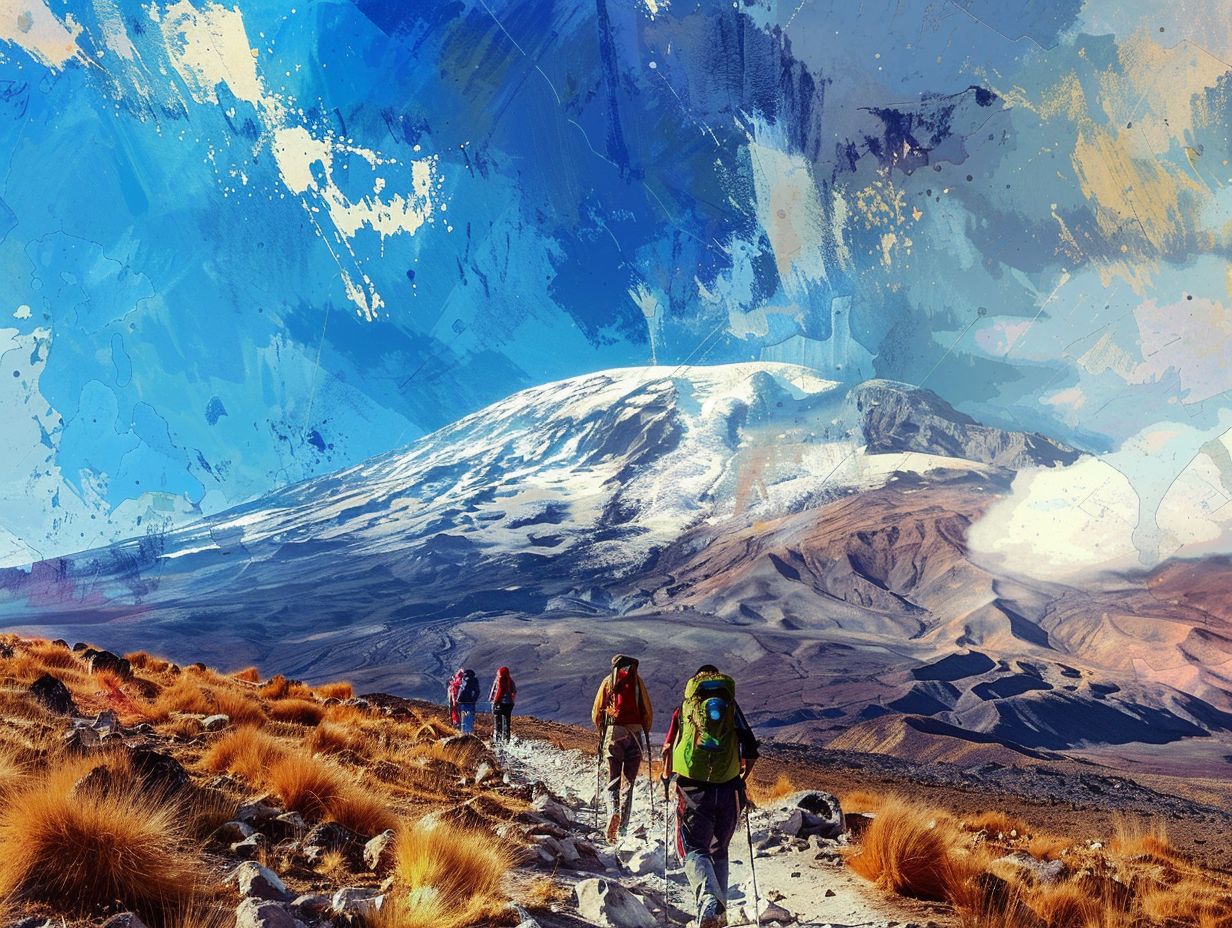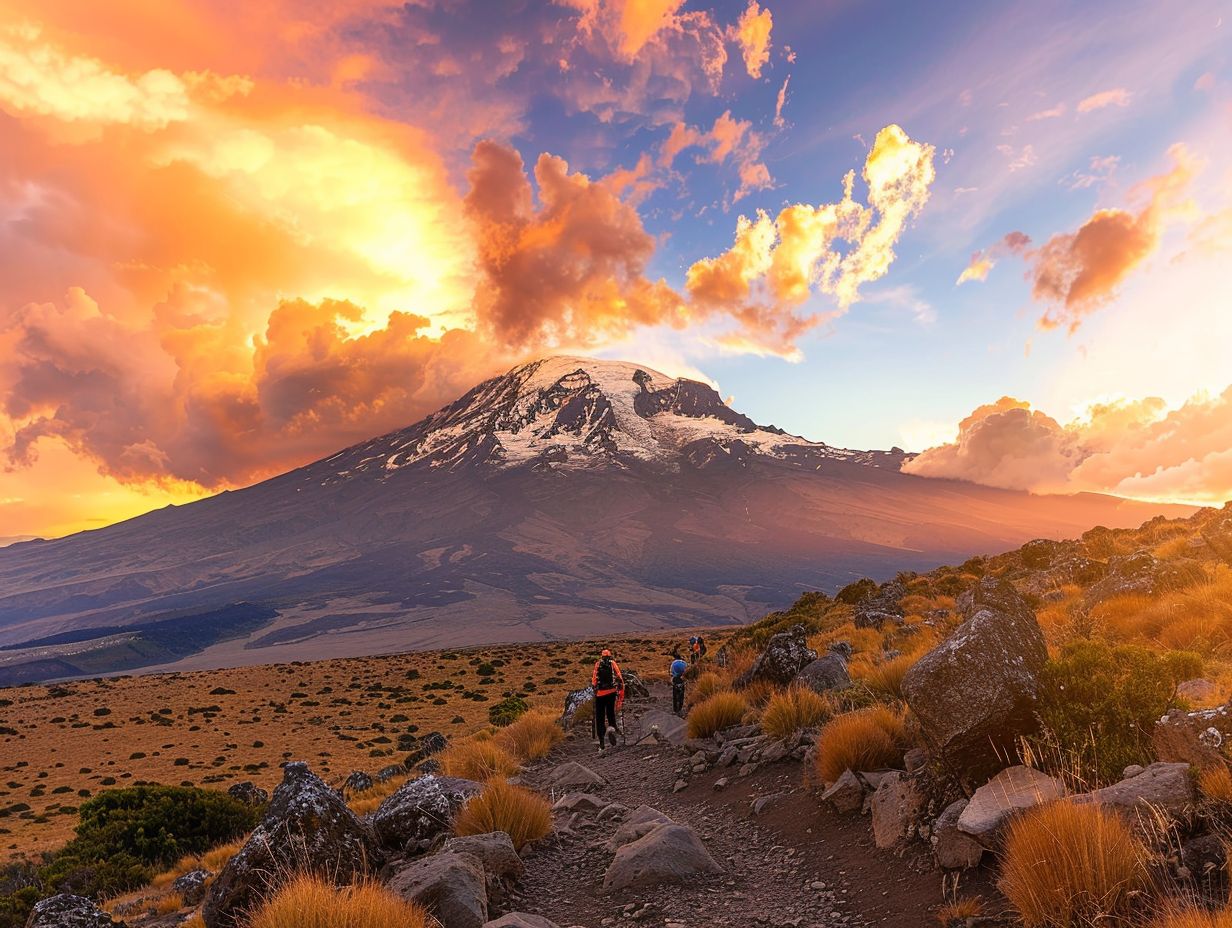
How Many People Die On Kilimanjaro And Why?
Climbing Mount Kilimanjaro is a dream for many adventure seekers, but it comes with its risks. Have you ever wondered how many people actually die on Kilimanjaro and what the main causes of death are?
We will explore the death rate on Kilimanjaro, the common causes of fatalities, and the risk factors associated with climbing this iconic peak.
Find out about the safety measures, emergency procedures, and precautions you should take before embarking on this challenging journey.
Key Takeaways:

- On average, approximately 10 deaths occur each year on Kilimanjaro, making it one of the most challenging and dangerous summits to conquer.
- The main causes of death on Kilimanjaro include altitude sickness, severe weather conditions, and physical exhaustion due to the strenuous climb.
- To minimize the risk of death while climbing Kilimanjaro, it is important to prepare physically, mentally, and have the necessary gear and equipment, as well as undergo recommended health checks before attempting the climb.
How Many People Die on Kilimanjaro?
When considering the number of fatalities on Mount Kilimanjaro, one must delve into the statistics and circumstances surrounding the deaths that have occurred over time.
Studies have shown that the mortality rate for climbers attempting to conquer the majestic mountain varies depending on the routes taken and the experience levels of the climbers. While the overall death rate is relatively low, it is essential to understand the risks involved in such a challenging ascent. Instances of deaths often occur due to altitude-related illnesses, harsh weather conditions, or accidents during the climb.
The lack of proper acclimatization, inadequate physical preparation, or underlying health issues can contribute to the unfortunate fatalities among climbers. Every year, the mountain claims a few lives, serving as a reminder of the dangers and challenges that come with attempting to reach its summit.
-
What is the Death Rate on Kilimanjaro?
The death rate on Kilimanjaro is a vital metric that sheds light on the risks and safety measures required when undertaking the climb.
Accurate statistics regarding the mortality rate among climbers on this majestic peak can provide valuable insights for mountaineers and expedition organizers. Analysis of the death rate trends over the years can highlight patterns and potential areas for improvement in safety protocols.
Understanding the factors contributing to fatalities, such as altitude sickness, falls, or extreme weather conditions, is crucial for minimizing the deaths on Kilimanjaro expeditions. By studying these statistics, climbers can better prepare themselves and mitigate potential risks before embarking on this challenging adventure.
-
What are the Main Causes of Death on Kilimanjaro?
Understanding the main causes of death on Kilimanjaro is crucial to mitigate the risks associated with climbing, with altitude sickness and severe AMS being prominent factors.
Altitude sickness, particularly Acute Mountain Sickness (AMS), is a common condition affecting climbers due to the rapid ascent to high altitudes, where the body struggles to acclimatize to the decreasing oxygen levels.
This can lead to symptoms such as headaches, nausea, and fatigue. If not managed properly, AMS can progress to more severe forms, such as High Altitude Pulmonary Edema (HAPE) and High Altitude Cerebral Edema (HACE), both of which are life-threatening conditions. Inadequate acclimatization, dehydration, and physical exertion are often contributing factors to the development of severe altitude sickness, increasing the risk of fatalities among climbers on Kilimanjaro.
What are the Risk Factors for Climbing Kilimanjaro?
Embarking on a journey to climb Mount Kilimanjaro involves confronting various risk factors that stem from the challenging terrain and high altitudes.
Among the dangers faced by climbers are extreme weather conditions, including sudden temperature drops and high winds, which can lead to hypothermia or frostbite if proper precautions aren’t taken.
As climbers ascend to higher altitudes, they may experience health issues such as altitude sickness, characterized by symptoms like headaches, nausea, and fatigue. It’s crucial for climbers to acclimatize properly and recognize the signs of altitude sickness to avoid potentially life-threatening situations.
-
What is the Altitude Sickness on Kilimanjaro?

Altitude sickness on Kilimanjaro, including Acute Mountain Sickness (AMS), poses a significant threat to climbers due to the rapid altitude gain and decreased oxygen levels.
AMS, a common form of altitude sickness, can manifest in symptoms like headaches, nausea, and fatigue, often occurring above 8,000 feet. Dehydration worsens the effects of AMS as it impairs the body’s ability to acclimatize to high altitudes.
Adequate hydration plays a crucial role in preventing altitude sickness on Kilimanjaro by ensuring proper blood circulation and oxygen delivery to tissues. Maintaining optimal oxygen levels through slow ascent rates and rest breaks aids in reducing the risks associated with high altitudes.
-
What are the Weather Conditions on Kilimanjaro?
The weather conditions on Kilimanjaro are unpredictable and can range from scorching heat to freezing cold, presenting challenges such as hypothermia and treacherous rocky terrain.
Strong winds can exacerbate the already challenging conditions, making navigation difficult for climbers. In certain areas, rocks are prevalent, increasing the risk of falls and injuries. Rapid changes in weather conditions can catch climbers off guard, leading to frostbite or heat exhaustion.
It is crucial for climbers to be well-prepared with suitable gear, including layers for insulation and protection against the rugged terrain. Adhering to experienced guides’ advice and being vigilant in adapting to the ever-changing weather conditions are paramount for a safe ascent.
-
What are the Physical Demands of Climbing Kilimanjaro?
Climbing Kilimanjaro demands physical endurance, mental preparedness, and the ability to navigate challenging terrains while managing factors like dehydration and high altitude.
Due to the high altitude, climbers are at an increased risk of dehydration. The low humidity levels and physical exertion can accelerate fluid loss, leading to symptoms such as fatigue, headaches, and dizziness. It’s essential to stay well-hydrated by regularly consuming water and electrolyte-rich drinks.
The ascent to Kilimanjaro involves long hours of walking each day, often over uneven and steep terrain. Climbers must have adequate preparation by engaging in cardiovascular exercises, strength training, and endurance activities to build the required fitness level.
How to Prepare for Climbing Kilimanjaro?
Preparing for a Kilimanjaro expedition involves thorough planning, securing knowledgeable guides, and ensuring a comprehensive health check-up to assess one’s readiness for the climb.
Regarding preparation, creating a detailed itinerary is crucial to navigate the challenging terrain effectively. Knowledgeable guides play a pivotal role in not only leading the way but also ensuring safety and providing insightful information about the surroundings.
- Trekking essentials such as proper gear, including layers for varying weather conditions, durable footwear, and hydration supplies are non-negotiable for a successful ascent.
- A pre-climb health assessment is essential to identify any underlying medical issues that could affect the climb’s outcome and to ensure one’s well-being during the journey.
-
What is the Recommended Physical Training for Climbing Kilimanjaro?
Engaging in specific physical training routines tailored for climbing Kilimanjaro is essential to build endurance, acclimatize to high altitudes, and familiarize oneself with the necessary equipment.
Physical training not only enhances your cardiovascular fitness and muscle strength but also plays a crucial role in preventing injuries during the arduous climb. It is important to include exercises that target your lower body, core, and cardiovascular system to prepare your body for the demands of ascending a mountain.
Along with physical preparation, adequate acclimatization practices are vital for adjusting to the reduced oxygen levels at higher altitudes. Gradual ascents, hydration, and proper rest are all part of the acclimatization process, ensuring that climbers can safely reach the summit.
-
What are the Essential Gear and Equipment for Climbing Kilimanjaro?

The essential gear and equipment required for climbing Kilimanjaro encompass a range of items from proper footwear and clothing to hydration systems and trekking poles.
Dehydration poses a significant challenge on a Kilimanjaro trek, so it’s crucial to carry a water bottle or hydration pack to ensure you stay well-hydrated.
Wearing moisture-wicking clothing made of synthetic materials can help regulate body temperature and prevent excessive sweating, which can lead to dehydration.
Regarding trekking gear, invest in sturdy and comfortable hiking boots with ankle support to navigate the diverse terrains. Consider packing thermal layers, a waterproof jacket, and a wide-brimmed hat to protect against sun exposure.
-
What are the Recommended Health Checks before Climbing Kilimanjaro?
Undergoing comprehensive health checks before embarking on a Kilimanjaro climb is crucial to identify and address any underlying health issues, ensuring that precautions are taken to mitigate risks of illness during the trek.
When climbing Kilimanjaro, the high altitude can exacerbate existing health conditions or trigger new ones such as altitude sickness, hypothermia, or dehydration, making a thorough health check-up imperative. Taking the time for this evaluation can help climbers understand their physical limitations and prepare accordingly.
Alongside these check-ups, climbers must follow necessary precautions like staying hydrated, acclimatizing properly, and recognizing early signs of altitude-related illnesses. Being diligent about managing these health risks ensures a safer and more successful climb.
What are the Safety Measures on Kilimanjaro?
Implementing stringent safety measures while ascending Kilimanjaro is imperative to mitigate risks, ensure the well-being of climbers, and guarantee a safe and memorable mountain trek experience.
One of the key aspects of ensuring safety on the climb is understanding the inherent risks associated with high-altitude trekking. Kilimanjaro’s extreme altitude and rapidly changing weather conditions pose significant challenges to climbers. Climbing Kilimanjaro demands physical strength, mental preparedness, and a cautious approach to minimize potential hazards.
The role of porters cannot be understated in creating a safe climbing environment. They not only assist with carrying equipment but also provide valuable support, local knowledge, and emergency response if needed. Their expertise and assistance can greatly enhance the overall safety of the expedition.
To further enhance safety measures, climbers are advised to undergo proper acclimatization, maintain good physical fitness, stay hydrated, and listen to the guidance of experienced guides. Preparation and preventive measures play a crucial role in ensuring a successful and safe climb on Kilimanjaro.
What are the Emergency Procedures on Kilimanjaro?

Understanding and preparing for emergency procedures on Kilimanjaro is crucial in dealing with potentially life-threatening situations like hypothermia and oxygen deprivation at high altitudes.
It is imperative for climbers and guides to be well-versed in recognizing the signs of hypothermia, which include intense shivering, slurred speech, and drowsiness, and promptly implementing warming measures.
When faced with oxygen-related issues, such as altitude sickness or breathing difficulties, immediate descent to lower altitudes is the primary course of action. In critical situations, climbers should adhere to established rescue protocols, including maintaining communication with base camps and seeking assistance from rescue teams equipped to handle high-altitude emergencies.
What are the Precautions for High Altitude Climbing?
Taking necessary precautions for high altitude climbing on Kilimanjaro involves acclimatization strategies, monitoring weather conditions, and safeguarding against risks like altitude sickness and hypothermia.
Acclimatization is crucial as it allows the body to adapt gradually to reduced oxygen levels at higher altitudes, typically achieved through slow elevation gains.
Constant monitoring of weather conditions is essential to anticipate sudden changes that can drastically impact climbing conditions. In addition, preventing altitude sickness involves staying hydrated, consuming adequate calories, and recognizing early symptoms like headaches and nausea.
Addressing hypothermia risks requires proper layering of clothing, ensuring adequate insulation from the cold, and using protective gear to fend off extreme temperatures.
Frequently Asked Questions:
1. How many people die on Kilimanjaro each year?
A: On average, approximately 10-15 people die on Kilimanjaro each year. This number can vary depending on weather conditions and other factors.
2. What are the main causes of death on Kilimanjaro?
A: The main causes of death on Kilimanjaro are altitude sickness, falls, and heart attacks. Altitude sickness, also known as acute mountain sickness, can occur when climbing too quickly and not allowing the body enough time to acclimatize to the high altitude. Falls can happen due to steep and rugged terrain, and heart attacks can occur due to the strenuous physical activity required to climb the mountain.
3. What precautions can be taken to reduce the risk of death on Kilimanjaro?
A: Some precautions that can be taken to reduce the risk of death on Kilimanjaro include proper training and preparation, hiring a reputable guide, taking the recommended amount of time to acclimatize, and listening to your body for any signs of altitude sickness. It is also important to have proper gear and clothing for the climb.
4. Are there any rescue services available on Kilimanjaro?
A: Yes, there are rescue services available on Kilimanjaro. The Kilimanjaro Search and Rescue Team (KSRT) is a professional mountain rescue organization that operates on the mountain and is equipped to deal with various emergencies.
5. Are there any restrictions or requirements for climbing Kilimanjaro?
A: Yes, there are some restrictions and requirements for climbing Kilimanjaro. These include obtaining a permit, having a licensed guide, and following designated routes. It is also recommended to have a certain level of physical fitness and to be at least 10 years old to attempt the climb.
6. How does the number of deaths on Kilimanjaro compare to other mountains?
A: The number of deaths on Kilimanjaro is relatively low compared to other popular mountains, such as Mount Everest. This is due to a combination of factors, including the well-maintained trails, shorter duration of the climb, and the fact that it does not require technical climbing skills.